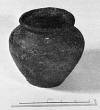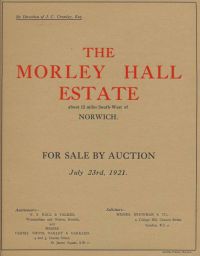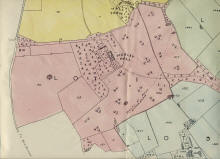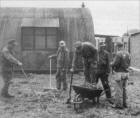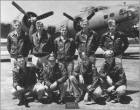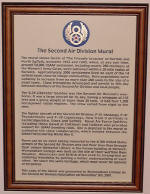|
|
The Romano-British Period
The Anglo-Saxon Period
19th Century
20th Century
The
Romano-British Period
AD43-AD410.
The Morley St Peter Kiln
from the 1963 College Magazine
In 1958, workmen digging foundation trenches for Fry Hall came
across two
Romano-British pottery kilns. These two kilns were excavated at the time. During
the excavation the side of a third kiln, which ran under a concrete path was
exposed. Unfortunately the path was in general use at that time and could not
be removed.
In the summer of 1962 permission was
given for the removal of the path and a team
of amateur archaeologists from the College set to work, under the direction of Mr. Bawden.
At first the concrete stubbornly refused to
budge, but after the party had acquired a little
ingenuity and a painful selection of blisters
the path collapsed in pieces and the real work
of excavation began. Work proceeded quickly
and efficiently under Mr. Bawden's supervision,
and within the first week of the holidays the
whole of Kiln III was exposed and recorded.
The late Mr. R. Rainbird Clarke, Curator of Norwich Museum, was then working at Hockwold and he called in on his way home on most evenings to offer advice and help, for which we were all very grateful. On the second Saturday of the holiday the trench was filled in in record time and a message was placed in a bottle at the bottom of the kiln for the guidance or possibly confusion of future generations. Romano-British pottery kilns containing 20 Century glass are not often found!
| The excavation, with Tomlinson Hall behind | Timothy Howe with a 'find' |
The kiln was small, but typical of Romano-British Kilns. It contained a large quantity of broken coarse-ware, among which were two fine flagon necks, the prize finds. The quantity and quality of soot remaining in the kiln was a surprise to most of us. Skipper [Keith - Ed.], who was responsible for the removal of most of the infill from the stokehole and flue, looked more like a painted savage than an archaeologist on many occasions. The work was tiring but very rewarding, and we went to bed on most mornings eager to start again. The kitchen staff kept us fed like kings, and the large number of tea-breaks were very welcome after a few hours' work in the hot sun. On the occasions when rain threatened to stop work we crouched under asbestos sheets placed over the trench and carried on our work in a damp and musty half light; such was the enthusiasm of the party.
We all hope that in future years digs may be organised from the College. A Roman road has been traced up to Attleborough and is recorded as far as Wymondham in the other direction. There has been much speculation that the untraced section may pass very close to the College. Let us hope that members of the College will have the opportunity of plotting this road at some future date and enjoying a similar experience to ours last summer in carrying out archaeological fieldwork.
TIMOTHY HOWE
"There has been much speculation that the untraced section may pass very close to the College" - It may indeed! See the 19th Century section below.
The
Anglo-Saxon Period
AD410-AD1066
The Morley St
Peter Hoard
from the 1970 College Magazine
Early in 925 one of the former inhabitants of Norfolk wanted to hide his wealth. He dug a small round hole and buried in it a pot containing his treasure. But he never recovered it. Over a thousand years later, on Friday, 24th January, 1958, two workmen dug a trench to carry pipes to the first two staff houses then being built at Wymondham College. Unwittingly they had cut through the side of the hole dug 1033 years earlier. It snowed that week-end, and when the snow melted, the pot of coins and the earth which filled the hole fell from a depth of about 2' 3" into the trench. So when the workmen arrived on Monday, 27th, to put in the pipes they were annoyed to find that part of their trench, about ten yards from the houses, had collapsed. One started to shovel the earth, and a shower of shining silvery discs "like mineral water bottle caps" suddenly came to light. The men became curious about the portraits on many of them, and decided to ask for advice ...
| One of the coins, inscribed 'EADWEARD REX' | Site of the discovery, looking south | The jar containing the coin hoard |
Later in the morning, at the suggestion of Mr. Powell, Head of
the History Department, the Warden telephoned the Castle Museum in Norwich.
Since no comparable discovery had been made since 1872 the Curator, the late Mr.
Rainbird Clarke, was incredulous at Mr. Metcalfe's story - until he saw the
coins himself an hour later. Then he promptly notified the police, and P.C.
Massingham arrived to make sure that no-one had collected any "souvenirs". The
museum archaeologists made a more extensive search the next day. Two College
sixth formers, members of the Norfolk Research Committee, assisted them, Lionel
Kett and Peter Guildford, who later prevented the complete destruction by
bulldozing of two Romano-British pottery kilns buried beside Tomlinson Hall. By
sieving the earth they recovered nine more coins and the remaining fragments of
the pot which had contained them. Nearby were animal bones and fifty shreds of
late Saxon pottery, which showed that the area had been occupied in the tenth or
the eleventh century: it was most improbable that there should be another hoard
in the vicinity.
The identification of hundreds of Saxon silver pennies is a task for
specialists. In view of the obvious importance of the discovery Mr. R. H. M.
Dolley, the expert on Saxon coins at the British Museum, was assisted in
classifying the coins in Norwich by Mr. C. E. Blunt, President of the Royal
Numismatic Society, and Mr. D. M. Metcalf of St. John's College, Cambridge.
Their preliminary work was essential to the legal question, who owned the coins.
To decide this the Norfolk District Coroner held an inquest at the College on
10th February in Room 7A, which then housed the library.
By English law gold and silver objects whose rightful owner cannot be traced are
"treasure trove", and therefore the property of the Crown. At the inquest the
jury agreed that the coins had been hidden with the intention of later recovery
by an unknown owner in or about 925. The hoard was therefore declared treasure
trove and "seized" for the Crown. The "Crown" does not necessarily retain all
treasure trove, but if it does the finder is normally rewarded to the full
market value of the discovery. Ultimately the two workmen who were named as
joint finders shared £2,700, and one of them, who had been living with his
family in a caravan, was able to buy a house.
Since the find constituted a "hoard" (three coins or more) any associated
objects not of gold or silver were also treasure trove, in this case the pot.
Completely reconstructed, it was identified as a wheel-made jar of "Thetford
ware", itself of value in helping to establish a securely dated sequence of
Anglo-Saxon pottery.
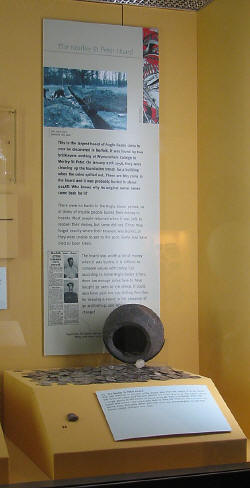 All 883 coins were studied in the British Museum, and it was decided to retain
the rarest there. Most were returned to the Castle Museum, Norwich, where they
are normally to be seen, with the pot, in a showcase in the medieval room.
Exceptionally, it was decided to present six to the College. Of these, five are
of Edward the Elder (four from an East Midlands mint, one from a Southern mint)
and the other of King Alfred (Southern mint).
All 883 coins were studied in the British Museum, and it was decided to retain
the rarest there. Most were returned to the Castle Museum, Norwich, where they
are normally to be seen, with the pot, in a showcase in the medieval room.
Exceptionally, it was decided to present six to the College. Of these, five are
of Edward the Elder (four from an East Midlands mint, one from a Southern mint)
and the other of King Alfred (Southern mint).
The coins are best classified in three chronological groups. The first comprises
107 coins, starting with one of Ceolwulf II of Mercia (c.875). Some were of East
Anglian rulers, including Athelstan II; some commemorated St. Edmund (martyred
in 869); but most of the group were coins of Alfred, struck in the south-east of
his kingdom in the last decade of his reign. The second is a small group of 16
Northumbrian coins struck at York between c.900 and c.915. All the rest were
coins of Edward the Elder, struck late in his reign, with the exception of a
single coin, a penny of Athelstan, who began minting in 924. It is this last
coin which makes it reasonably certain that the hoard was buried in the winter
of 924-5.
The Morley St. Peter hoard, as it is called, after the Parish in which it was
found, was, and is, of exceptional interest to scholars. Miss Dorothy Whitelock,
newly appointed Professor of Anglo-Saxon in the University of Cambridge, made
some tentative suggestions about its implications in her inaugural lecture, less
than a month after the discovery. Mr. Rainbird Clarke and Mr. Dolley published
an interim report on it in the journal "Antiquity" later in the year. Last
summer Mr. Dolley, now a lecturer in the University of Belfast, returned to
Norwich in order to prepare a complete report. (While he was at the British
Museum Mr. Dolley had been very keen to give a talk at the College, but
arrangements had to be cancelled owing to his breakdown in health, and he left
England not long after his recovery.)
In 1958 it was well known among scholars that Edward the Elder reconquered most
of East Anglia from the Danes in 917 and ordered that one coinage was to be
current throughout his dominion. It is one thing to issue orders, but another to
get them obeyed, and it was uncertain how securely Edward controlled Norfolk.
The absence from the Morley St. Peter hoard of Danish, Carolingian and other
coins known to be common elsewhere in England at the time, provides the first
clue to an answer. But further, the overwhelming majority of the coins were
struck almost certainly at Norwich after 917, and are therefore a silent
testimony to Edward's power, competence and speed of operation.
Almost certainly at Norwich. It is known that Athelstan had a mint at Norwich by
930 - coins bear the name "Northwic" - and it may now be assumed that a mint had
been established there about ten years before. A mint implies a flourishing and
safe commercial centre, and thus the hoard helps to throw light on the growth of
Norwich, generally held to be a very small township in 850, but the largest town
in East Anglia by the time of the Norman Conquest. The Danish occupation gave
the impetus to the growth of Norwich - as of Thetford.
Thetford, the other possible mint town, was the winter headquarters of the
Danish "Great Army" in 869 and second in the region only to Norwich by 1066. But
Thetford does not appear on coins before c.960. (Not all coins bear mint town
names). The small group of coins from the York mint implies trade between the
Danes of East Anglia and those of S. Northumbria. Since the coins were all
pre-915 Professor Whitelock suggested that this trade stopped when Norsemen from
Ireland captured the kingdom of York c.919. But might not Edward's victory and
order in 917 suggest another explanation? Until this is resolved the identity of
the owner of the hoard must remain a mystery, and why he buried it that winter.
Where he buried it gives rise to more speculation. There was no permanent
structure nearby, but he expected to identify the spot later. What were the
bases of his co-ordinates? Roman roads are known to have been used elsewhere,
and there is independent evidence to suggest at least one, perhaps more, in
Morley.
The story has not ended yet.
Mr R.A. Bawden
WCR Editor's note: A related report in the Eastern Daily Press named the workmen who discovered the coins as Mr Alfred Harvey, of Spixworth, and Mr Frederick J. Bird of 62a Unthank Road, Norwich.
The maps referred to below are accessible on-line via the Norfolk County Council E-map Explorer web site. Use post code NR18 9SZ. See also the 1797 and 1826 maps of the area on the Maps & Plans page
Enclosure Map (c1805)
The land is bounded to the West by what we now know as Golf Links Road, but it is named on the map as the 'Wicklewood and Besthorpe Road.' Ownership of the Land is split between J. Matthews (west), Peter Mason (south) and Brownes Trustees (north and east). The Browne family were major landowners in the Wymondham area, as will be seen later.
The most interesting feature of the map is labelled 'Old Turnpike;' running along the bottom boundary of the present College site. The image below shows its location on an overlay of the Enclosure map and a 1988 aerial photograph:
 |
The Morley St Peter Hoard was found in the vicinity
of the staff houses very close to the route of
the turnpike - as Mr Dick Bawden suspected in 1970. Perhaps there
needs to be some further investigation?
|
Tithe Map and Directories (c1845)
The field layout on the Tithe map is much the same as it is shown on the Enclosure map, but the most important addition is that of a building (the present Morley Hall). The White's Directory of Norfolk 1845 entry for Morley St Peter says that the Parish has "191 souls and 1009 acres of land, mostly the property of J.T. Graver Browne, Esq., the Lord of the Manor, who resides at Morley House, a handsome white brick mansion, erected 4 years ago, in a fine lawn, well studded with oak and other trees, and commanding extensive views. The Old Hall, anciently the seat of the Sedleys, is encompassed by a deep moat."
It was only when the old Hall (different location in the Parish) fell into disuse later in the Century that Morley House became Morley Hall. Elements of the Graver Browne coat of arms are incorporated in the Wymondham College badge. The family motto was 'Sur Esperance' (Upon Hope).
Return of Owners of Land (1873)
The 1873 Return of Owners of Land records, in tabular form, the name, location and acreage of the holdings in Norfolk. Browne family members account for 280 acres in Wymondham, 1970 acres in Morley St Peter and 248 acres in Morley St Botolph. The Morley St Peter figure is surprising, given that the Parish total stated in White's Directory was only 1009 acres!
1st Edition Ordnance Survey Map (c1890)
Morley House has now become Morley Hall and the position of a gravel pit is marked in the woods to the south of the Hall. The pond is shown and was probably at that time a marl pit.
It was interesting to find that the George public House on the main Wymondham-Attleborough road was at that time The King of Prussia. The name was changed at the time of the First World War, for obvious reasons!
Sale of Morley Hall
The Hall and the surrounding estate, farms and houses were sold by auction in 1921. The particulars were found via the excellent AbeBooks web site and have been converted into a PDF file (2.4 Mbytes). The accompanying map was too large to scan in one piece, so the image below represents 'Lot 1' - the area occupied by the College.
Mid-Norfolk Golf Club
Presumably as a consequence of the above sale, the Mid-Norfolk Golf Club was established on the site over the period of the inter-war years. There were at least two associated buildings: the club house and the golf professional's bungalow. The former was moved and rebuilt by College staff to become the cricket pavilion and the latter was demolished in summer of 1964. The following aerial photo shows where the bungalow stood next to Golf Links Road (click to enlarge). The club house was also next to the road, about 50 yards to the north-west.
Food production became a priority. The golf course was taken over by a local farmer, Mr G.L. Peacock, who levelled the tees, filled the bunkers and managed to achieve one season's crop before the site was requisitioned by the Ministry of Works in 1943 as the location for a military hospital to support nearby bases of the US 8th Army Air Force.
Construction of the hospital was overseen by Clerk of Works Mr Winstanley and the Contractors were Messrs. Gee, Walker and Slater. The hospital was built under Lend Lease arrangements and was completed in September 1943. The first established unit was the USAAF 77th Station Hospital and this was later reorganised to become the 231st Station Hospital on 6th March 1944. A map of the site can be found on the Maps & Plans page.
Anne Hoare (Housemistress of Cavell Hall in the 1990s) carried out a lot of research into the history of the hospital and a fraction of her findings is contained in these PDF documents: Part 1 Part 2. Similar material was displayed on a Wymondham Heritage web site that is now defunct following the death of its webmaster, Graham Barrell.
The Hospital served 15 bomber bases, a fighter group and affiliated service organisations such as engineer, quartermaster and ordnance troops; an estimated 60,000 men. Most of the work of the surgical services was carried out on casualties arising from high-altitude missions by the bomb wings over France, Norway, Holland and Germany. Some statistics:
-
60% of casualties resulted from flak, 15% from cannon shell fragments and the rest from crashes and accidents.
-
The general age of patients was 18-30 years and almost all injuries were classed as severe.
-
Almost 80% of wounds involved upper and lower extremities, 15% the head and only a small number the chest and abdomen, due to the effectiveness of protective flak jackets worn by the crew.
-
2099 patients arrived by hospital trains in 1944 as a result of the D-Day landings.
| In 1973 a John R. Woodman of Peel Hall wrote to the Historical Unit of the Department of the Army asking for information about the Hospital. Copies of the Annual Reports for 1944 and 1945 were received and eventually filed away, to be rediscovered recently when the Admin staff moved into new accommodation (2007). The reports make fascinating reading. They have been scanned and converted to PDF format. Note that the Contents pages, photographs and Appendices (details of medical procedures) are missing. |
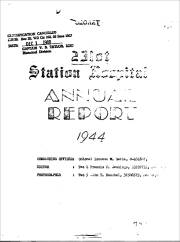 |
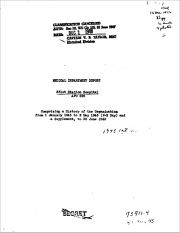 |
|
1944 report (1.2 MB) |
1945 report (700 KB) |
The 1945 report includes a statement that, in January 1945, Major Thomas A. March made a psychiatric examination of Private George E. Smith who was accused of the murder of British diplomat Sir Eric Teichman. Research has revealed the following details:
On 3 December 1944, George Smith had gone hunting on private property (Honingham Hall) with fellow soldier Leonard Wojtacha, both armed with service carbines. They were challenged by the owner, diplomat Sir Eric Teichman and in the course of this confrontation Smith shot Sir Eric once through the head, killing him. See also 'Murder at Honingham Hall.' The Hall was demolished in 1966.
The court martial took place at Attlebridge in Norfolk, commencing on the 8th of January 1945, and lasted five days due to the repeated hospitalisation of Smith. He had made a confession when he was arrested but claimed it had been made under duress and withdrew it at his trial. Major Leo Alexander, another Army psychiatrist, assessed that Smith had a mental age of "about nine years" and made a surprising announcement that the average mental age of U.S. Army enlisted men was between 13 and 14 years, only slightly higher than it was found to be in World War I.
"This is just a note to thank you for the fascinating and utterly moving USAAF 231st Station Hospital's report for 1944 in the Pre-History section which you recently made available. It really does give a vivid picture of wartime life at the College site before we got hold of it, and the level of detail concerning facilities, equipment and logistics available there at the time. It pains me to think that we imagined we were suffering during our time at Wymondham compared to then, in contrast to their level of fortitude and cheerful resilience perceivable from a formal detailed report." - David Cook
The nearest airfield was at Deopham Green, headquarters of the 452nd Bombardment Group (Heavy) that comprised the 728th, 729th, 730th and 731st Bombardment Squadrons. The Group flew 250 daylight combat missions between 5 Feb 1944 and 21 Apr 1945. Some details of what survives are on this page.
| 728th Squadron B-17G & crew | Squadron badges |
Some related links:
452nd Bombardment Group (Deopham)
452nd BG section of the 8th Air Force
446th Bomb Group (Bungay)
389th Bomb Group (Hethel)
The Hospital closed at midnight on 8th June 1945, but the College has not forgotten its links with the past and there are features today which remind students of the role that the site played before they and their parents were born.
 |
 |
||
|
The Memorial Garden |
2nd Air Division Mural | Chapel Painting (by Matthew Wood) |
WWII Veterans Visit the College 2012 |
Post-war Utilisation
The site remained in Ministry of War ownership for a short time and became a transit camp for the Royal Norfolk Regiment until at least August 1946 when it was a staging post for troops embarking overseas. It is also understood that Norfolk's fleet of Green Goddesses was stored there.
Between 1947 and 1950 the site was taken over by the Ministry of Education for Emergency Teachers' Training (separate page). Morley Hall was part of that establishment, but when Wymondham College came into being in 1951 the Hall was used by Norfolk County Council Education Department as a special school for maladjusted teenage boys with educational and/or social problems until at least the 1980s. Since 1995 the Hall has been the headquarters of Lambert Civil Engineering.
Wymondham College Remembered





